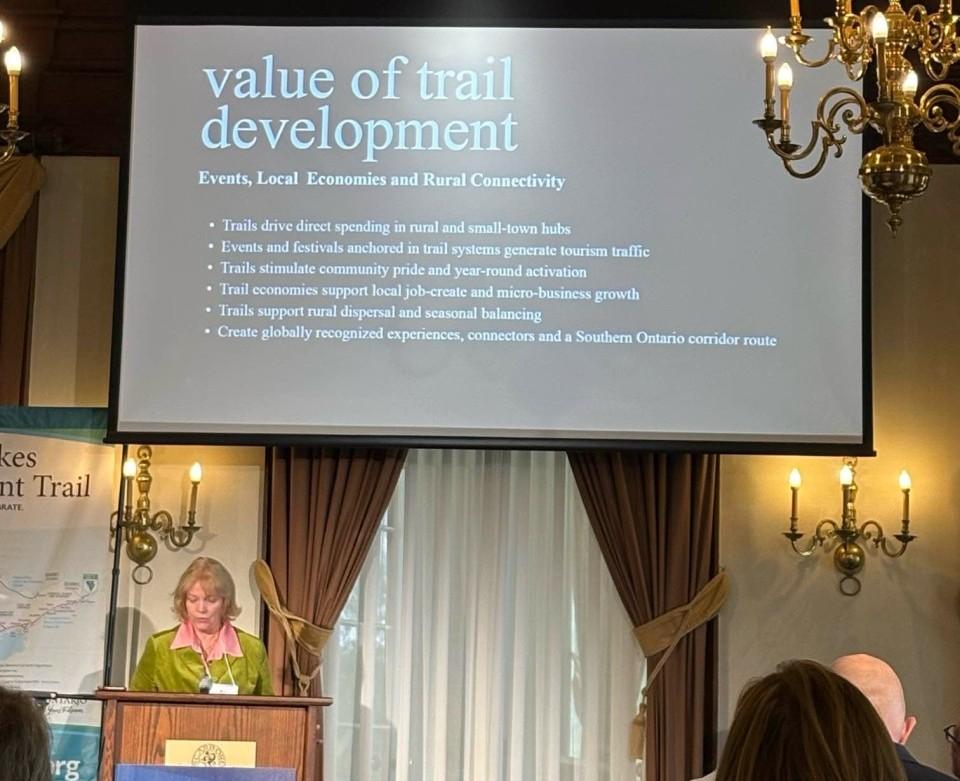In October, I had the privilege of representing Hamilton Halton Brant at the Waterfront Regeneration Trust Partner Meeting, held October 21 and 22 of 2025 at the Scarborough Golf and Country Club. The two-day event brought together partners and leaders from across Ontario committed to enhancing and celebrating the province’s extensive trail network.
I was honoured to serve as a panelist and presenter on the Celebrate Panel, alongside two other Ontario Regional Tourism Organization representatives. Together, we shared insights and best practices on destination development and community engagement through trail-based experiences and initiatives. The conference showcased best practices in trail development, maintenance, and community partnerships, highlighting how collaboration fuels both environmental stewardship and visitor experience. It also created valuable opportunities to network and build synergies among regions as we collectively advance our shared goals in destination stewardship and sustainable tourism along Ontario’s land and water trails.
This year also marked a milestone for the Waterfront Regeneration Trust, celebrating its 30th anniversary of leadership in trail development and environmental stewardship. Since its inception, the Trust has worked to realize a vision of a connected, accessible, and sustainable waterfront that links communities, natural spaces, and cultural destinations along the Great Lakes Waterfront Trail. Over three decades, the organization has championed collaboration among municipalities, conservation authorities, and tourism partners, transforming the Trail into a signature legacy project that supports active transportation, environmental preservation, and community vitality across Ontario. Spanning 32 kilometres through Hamilton Halton Brant, this portion of the Great Lakes Waterfront Trail highlights our region’s commitment to active living, sustainable tourism, and community connectivity for walkers, runners, and cyclists.
A highlight of the program was the Rouge National Urban Park tour, hosted in part by Parks Canada. Rouge National Urban Park is one of Canada’s most unique conservation projects, an expansive protected area within the Greater Toronto Area that spans over 79 km, connecting Lake Ontario to the Oak Ridges Moraine. The park’s vision is to protect and restore natural ecosystems while providing accessible urban greenspace for recreation, education, and cultural connection. It stands as a model for integrating conservation, agriculture, and community well-being in one of the most urbanized regions in the country.
During my presentation, I shared examples of our regional collaborations and ongoing initiatives with the Waterfront Regeneration Trust, local conservation authorities, and partners working across the Niagara Escarpment (a UNESCO World Biosphere Reserve), the Grand River (a designated Canadian Heritage River), and the Great Lakes Waterfront Trail. Our discussion emphasized the importance of tourism-friendly trail enhancements, interpretive trail stops, and linking trail infrastructure with authentic visitor experiences that celebrate our natural and cultural landscapes.
These initiatives are directly aligned with Hamilton Halton Brant’s sustainability goals, promoting environmental preservation through responsible trail development, supporting local towns and businesses by encouraging visitation to nearby communities, and celebrating cultural authenticity through storytelling, heritage interpretation, and local engagement.
Key Takeaway
The key takeaway from this year’s meeting was the strength of our growing relationships with trail-focused partners and destination development initiatives that reflect our region’s commitment to sustainability, community vitality, and regenerative tourism. The discussions helped initiate new conversations on linking trail systems, enhancing visitor experience and market-readiness, and identifying opportunities for shared investment in sustainable trail infrastructure.
Together, these collaborations are helping us build a more connected, responsible, and story-rich trail network that strengthens community pride, supports local economies, and celebrates cultural authenticity. Moving forward, we see a collective opportunity to advance trail corridor development with the Niagara Escarpment as the hero destination, uniting Ontario’s escarpment communities under a shared vision of conservation, accessibility, and world-class trail-based experiences.
Written by Bev Scott, Manager, Business and Visitor Experiences Development
November 6, 2025


